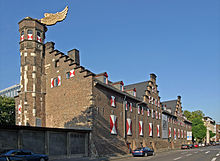Armory (Cologne)
The Cologne Zeughaus is a building built between 1594 and 1606 as a municipal arsenal in the Altstadt-Nord district , which has been part of the Cologne City Museum building complex since 1958 .
location
The armory was built on the site of the late medieval Blidenhaus. It rests on the remains of the Roman city wall on its south side on today's “Burgmauer” street . Zeughausstraße runs on the north side.
history
The construction of the armory or its predecessor took place in connection with the organized city defense, initially by the so-called gaffs , later by the city administration. The predecessor building, mentioned for the first time in 1348, was intended as a “Blidenhaus” or “Werkhaus” for storing heavy weapons. A blide was a medieval sub-form of the catapult .
When the previous building no longer met the requirements of the defense order of 1583, the armory was built between 1594 and 1606 as a municipal arsenal ( stuff = armor). Planning and execution came from city architect Peter von Siberg, replaced by city stone mason Peter von Blatzheim and completed by Matthias von Gleen.
In the 19th century the building was significantly rebuilt.
During the Second World War, the building burned down to the outer walls in two air raids in 1942 and 1943. After the war, the city initially regained the right to use the ruins and tried to repurchase the building for the Historical Museum - at that time still housed in Deutz - which was also done.
Since July 1st, 1980 the armory has been registered in the monuments list of the city of Cologne .
Building description
It is a simple brick building, influenced by the Dutch Renaissance , with a length of 66.80 meters and a width of 17.15 meters.
On the north side it is divided into three rows by twelve strictly rhythmic window axes . These are asymmetrically interrupted by a jewelry portal that was created by Peter Cronenborch around 1595 - this was not part of the original planning, but turned out to be somewhat disproportionate and was intended to symbolize the “fame and power of the city of Cologne”.
The street level on the south side is higher, so that the facade only opens here through a larger and a smaller row of windows.
The full-length gable roof is interrupted on both long sides by two stepped gables. On the west side, an octagonal stair tower with a height of 23.60 meters rises slightly above the gable.
The interior was on the ground floor, where the heavy weapons were stored, spanned by 25 vaulted fields and divided into two aisles with pillars. The upper floor housed a ballroom decorated with inlays; however, the lighter weapons were also stored here. The upper and attic floors had no windows and were intended for food storage.
A magnificent portal that led from the stair tower to the ballroom on the upper floor is now in the town hall .
During the reconstruction after the Second World War, the lower two floors were equipped with flat ribbed ceilings and connected with a cantilevered staircase in the style of the 1950s. The columns remained, but without vaults.
In 1991 the artist HA Schult installed the Golden Bird , an original Ford Fiesta with huge wings, on the stair tower as a “monument to the car era” .
use
The arsenal never really had to be used and was in a "twilight sleep" for a long time. It has also served "museum" purposes since the 17th century - weapons and objects that were no longer needed for travelers were decorated with appropriate horror stories . A headless mummy and the chariot from the Battle of Worringen in 1288 are said to have been shown.
Only with the entry of the French troops into Cologne in 1794 did this idyll come to an end. The armory came into government ownership and was cleared out. Some of the objects were brought to France, some made a detour to the collection of Ferdinand Franz Wallraf , then to the Wallraf-Richartz Museum and finally, in the 20th century, back to the Zeughaus with the Cologne City Museum.
Even under French and subsequent Prussian rule, the armory continued to be used as an arsenal. It was not until the demilitarization of the Rhineland that it was used for civil purposes, from 1920 onwards by the state tax office. After the Second World War and the reconstruction of the ruins, the Cologne City Museum moved into construction. The lower two floors have been unused since 2017 due to water damage, the upper floors are still used by the museum's workshops and administration.
Web links
Individual evidence
- ↑ a b c d e Johannes Ralf Beines: Zeughaus 2 . In: Stefan Lewejohann (Ed.): Cologne in unholy times . Böhlau, 2014, p. 27-42 , doi : 10.7788 / boehlau.9783412217938 .
- ↑ a b c d e f Cologne City Museum | Zeughaus and Alte Wache. Retrieved July 5, 2020 .
- ↑ a b Rita Wagner: New place - new name: The Cologne City Museum moves into the armory . In: 125 Years of the Cologne City Museum: Bought 125 times - given - donated . Emons, Cologne 2013, ISBN 978-3-95451-236-2 , pp. 153-155 .
- ^ A b Mario Kramp: Civic pride and old Cologne. Cologne's Historical Museum in Hahnentorburg and Eigelsteintorburg 1888–1924 . In: 125 Years of the Cologne City Museum: Bought 125 times - given - donated . Emons, Cologne 2013, ISBN 978-3-95451-236-2 , pp. 13-15 .
Coordinates: 50 ° 56 ′ 28.8 ″ N , 6 ° 57 ′ 1.6 ″ E



